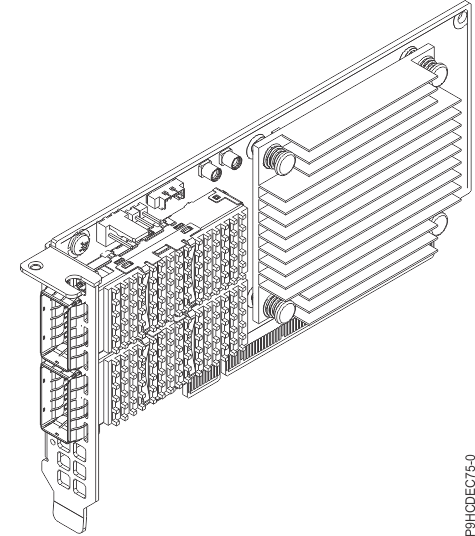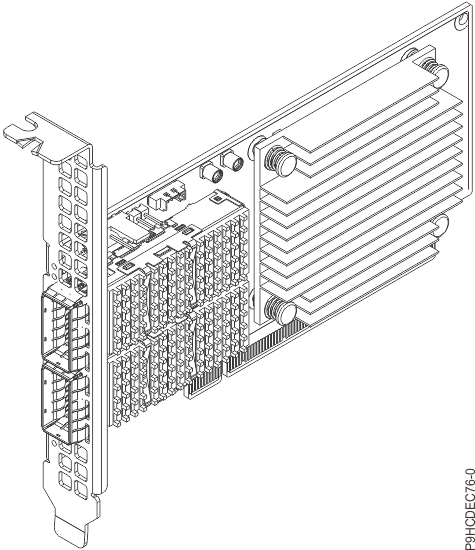PCIe4 2-port 100GbE RoCE with Crypto x16 adapter (FC EC77 and EC78; CCIN 2CFA)
Learn about the specifications and operating system requirements for feature code (FC) EC77 and EC78 adapters.
Overview
FC EC77 is a low-profile adapter and FC EC78 is a full-height adapter.
The PCIe4 2-port 100GbE RoCE with Crypto x16 adapter is a PCI Express (PCIe) generation 4 (Gen4) x16 adapter. The adapter provides two 100GbE En ConnectX-6 DX QSFP56 ports. The secure-key adapter provides both cryptographic coprocessor and cryptographic accelerator functions in a single PCIe card. This adapter is suited for applications that require high-speed, security-sensitive, RSA acceleration, cryptographic operations for data encryption and digital signing. Additionally, the adapter is useful in secure management, use of cryptographic keys, or custom cryptographic applications. It provides secure storage of cryptographic keys in a tamper-resistant hardware security module that is designed to meet FIPS 140-2 level 4 security requirements. The adapter runs in dedicated mode only.


Specifications
- Item
- Description
- Adapter FRU number
- 02CM993
- I/O bus architecture
- PCIe4 x16
- Slot requirement
- For details about slot priorities, maximums, and placement rules, see PCIe adapter placement rules and slot priorities and select the system you are working on.
- Cables
-
For 100G, IBM® offers either Direct Attach Copper (DAC) cables up to 2 M or Active Optical Cables (AOC) up to 50 M. Quad Small Form-factor Pluggable (QSFP) based transceivers are included on each end of these cables. For more information about adapter cabling, see the Cable and transceiver matrix.
- Transceivers
-
IBM qualifies and supports QSFP optical transceiver (FC EB59) to install into the adapter. You can also use your own optical cabling and QSFP56 optical transceiver for the other end. This 100GBASE-SR4 based active optical transceiver is available up to 100 M through the OM4 cable or 70 M through OM3 cable. Either one or both of the two QSFP56 ports on the adapter can be populated. When two ports are filled, both ports can have copper cables or optical cables. Additionally, one of the cables can be copper and the other can be optical.
- Cable and transceiver matrix
-
Table 1. Cable and transceiver matrix Feature Description EB59 100GBASE-SR4 optical transceiver MTP/MPO cable (purchased separately)
- FC EB2J - 10 M
- FC EB2K - 30 M
EB5J QSFP28 Passive Copper 100 Gb Ethernet Cable - .5 M EB5K QSFP28 Passive Copper 100 Gb Ethernet Cable - 1 M EB5L QSFP28 Passive Copper 100 Gb Ethernet Cable - 1.5 M EB5M QSFP28 Passive Copper 100 Gb Ethernet Cable - 2 M EB5R QSFP28 AOC 100 Gb Ethernet Cable - 3 M EB5S QSFP28 AOC 100 Gb Ethernet Cable - 5 M EB5T QSFP28 AOC 100 Gb Ethernet Cable - 10 M EB5U QSFP28 AOC 100 Gb Ethernet Cable - 15 M EB5V QSFP28 AOC 100 Gb Ethernet Cable - 20 M EB5W QSFP28 AOC 100 Gb Ethernet Cable - 30 M EB5X QSFP28 AOC 100 Gb Ethernet Cable - 50 M EB5Y QSFP28 AOC 100 Gb Ethernet Cable - 100 M EB2B 1 M Passive QSFP+ to QSFP+ EB2H 3 M Passive QSFP+ to QSFP+ EB27 or EB57 QSFP+ 40G BASE-SR4 optical transceiver MTP/MPO cable (purchased separately)
- FC EB2J - 10 M
- FC EB2K - 30 M
- Voltage
- 3.3 V, 12 V
- Form factor
-
Short, low-profile (FC EC77)
- Attributes provided
- PCI Express 4.0 (up to 16GT/s) x16
Operating system or partition requirements
- The latest version of enabling libraries and utilities can be downloaded from the Fix Central website.
- Power Systems Prerequisites website.
- IBM System Storage Interoperation Center (SSIC) website.
- The latest version of the device driver or IBM Power® RAID adapter utilities (iprutils) can be downloaded from the IBM Service and Productivity Tools website.
- For information about important notices for Linux on IBM Power Systems, see the Linux® on IBM website.